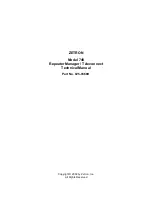
RADIANT PROPANE TANK TOP HEATER
Propane (LP) Odor Fading - No Odor Detected
• Some people have difficulty with smells and cannot smell the odor of the man-made chemical added to propane
(LP) or natural gas. You must determine if you can smell the odorant in these fuel gases.
• Learn to recognize the odor of propane (LP) gas and natural gas. It can be described as a "rotten egg" smell.
The odorant can fade over time so leaking gas is not always detectable by smell alone. Local propane (LP) gas
dealers will be more than happy to give you a scratch and sniff pamphlet. Use it to become familiar with the fuel
gas odor.
• Smoking can decrease your ability to smell. Being around an odor for a period of time can affect your sensitivity
to that particular odor. Odors present in animal confinement buildings can mask fuel gas odor.
• If there is an underground leak, the movement of gas through the soil can filter the odorant but the danger may
still exist.
• Propane (LP) gas odor may differ in intensity at different levels. Since propane (LP) gas is heavier than air, there
may be more odor at lower levels.
• Always be sensitive to the slightest gas odor. If you continue to detect any gas odor, no matter how small, treat it
as a serious leak. Take immediate action as discussed previously.
Critical Points To Remember!
• Propane (LP) gas has a distinctive odor. Learn to recognize these odors. Reference Propane (LP) Fuel Gas
Odor and Propane (LP) Odor Fading sections above. Make all persons aware of the heaters use and to always
be consciously aware of the odors of propane (LP) gas.
• If you have not read this manual or have not been properly trained in the use and service of propane (LP) gas
then do not attempt to light the heater, perform service or repairs, or make any adjustments to the heater on the
propane (LP) gas fuel system.
• A periodic sniff test around the heater or at the heater's connections; i.e. hose to heater and hose/regulator to
tank etc., is a good safety practice under all conditions. If you smell even a small amount of gas, CONTACT
YOUR FUEL GAS SUPPLIER IMMEDIATELY. DO NOT WAIT!
REFILLING THE PROPANE TANK
ALL NEW PROPANE TANKS MUST BE PURGED BEFORE THE FIRST FILLING.
• Turn heater gas valve knob and gas tank valve to OFF position.
• Thread POL fitting into interior threads of propane (LP) tank valve. This fitting has LEFT-HANDED THREADS
(reversed). Turn POL fitting COUNTER CLOCKWISE to tighten and CLOCKWISE to loosen. Protect POL
fitting from damage when disconnected from tank.
• Have tank filled by your local Propane gas supplier.
• Some propane (LP) tanks have a bleed-off valve. This valve should be inspected for leaks after each filling of
the tank. Turn clockwise to close the valve.
• Fasten full propane (LP) tank and connect POL fitting to tank valve by turning COUNTER CLOCKWISE .
• With heater gas valve knob still in the OFF position, turn ON tank valve and check all gas connections with a
50/50 liquid dish soap and water solution to be sure they are tight and leak proof. The formation of bubbles
indicate a gas leak. Correct all leaks before using the heater. Never use a flame to check for gas leaks.
7
Summary of Contents for ZBTT15
Page 1: ...ZBTT30 ZBTT15 ZBTT15 ZBTT30 ANSI Z83 7 CSA 2 14 2011 ...
Page 2: ...ZBTT30 ...
Page 4: ......
Page 5: ...ZBTT30 ZBTT30 ...
Page 6: ...ZOBO ...
Page 9: ...ZBTT30 ZBTT15 ...
Page 10: ......
Page 11: ...Local ZBTT15 ZBTT30 ...
Page 12: ......
































